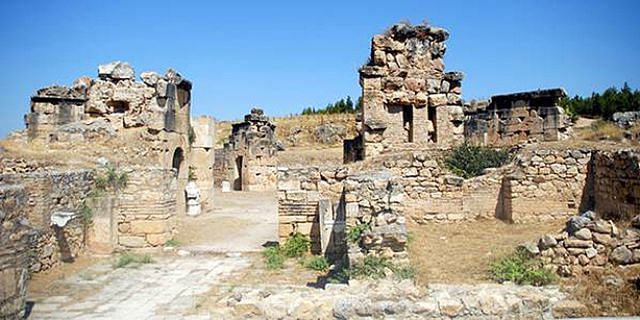'Gate to hell' discovered in Turkey
 The “gate to hell”, which is a cave that sits atop Pamukkale's famous travertines, was filled with lethal mephitic gases, according to ancient texts.
The “gate to hell”, which is a cave that sits atop Pamukkale's famous travertines, was filled with lethal mephitic gases, according to ancient texts.
Italian archaeologists have uncovered a "gate to hell" from ruins in southwestern Turkey.
Known as Pluto's Gate-Ploutonion in Greek, Plutonium in Latin-the cave was celebrated as the portal to the underworld in Greco-Roman mythology and tradition.
According to historic sources, the site was located in the ancient Phrygian city of Hierapolis, now called Pamukkale, and the opening was described as filled with lethal mephitic vapors.
Greek geographer Strabo (64/63 BC-about 24 AD) wrote that this space is full of a vapor so misty and dense that one can scarcely see the ground and any animal that passes inside meets instant death.
The finding, announced this month at a conference on Italian archaeology in Istanbul, Turkey, was made by a team led by Francesco D'Andria, professor of classic archaeology at the University of Salento.
"We found the Plutonium by reconstructing the route of a thermal spring. Indeed, Pamukkale' springs, which produce the famous white travertine terraces originate from this cave," D'Andria told Discovery News.
Featuring a vast array of abandoned broken ruins, possibly the result of earthquakes, the site revealed more ruins once it was excavated. The archaeologists found Ionic semi columns and, on top of them, an inscription with a dedication to the deities of the underworld-Pluto and Kore.
D'Andria also found the remains of a temple, a pool and a series of steps placed above the cave-all matching the descriptions of the site in ancient sources.
According to D'Andria, the site was a famous destination for rites of incubation. Pilgrims took the waters in the pool near the temple, slept not too far from the cave and received visions and prophecies, in a sort of oracle of Delphi effect. Indeed, the fumes coming from the depths of Hierapoli's phreatic groundwater produced hallucinations.
D'Andria and his team are now working on the digital reconstruction of the site.

 For all latest news, follow The Daily Star's Google News channel.
For all latest news, follow The Daily Star's Google News channel. 



Comments